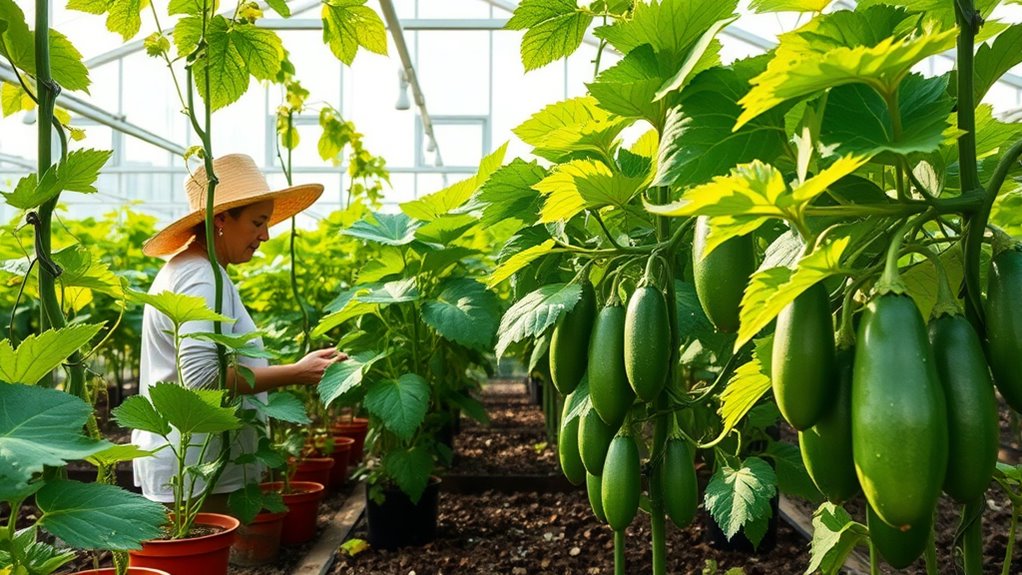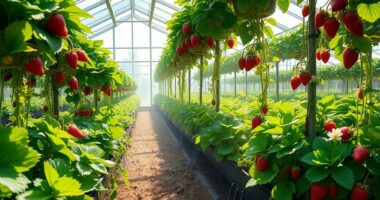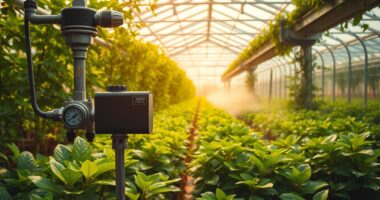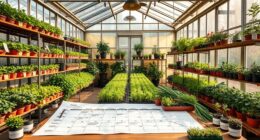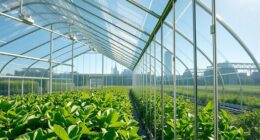To grow cucumbers in a greenhouse, start by choosing the right variety, like parthenocarpic types for seedless fruits. Set up your environment with temperatures between 75°F and 80°F, and maintain humidity around 60-70%. Sow seeds indoors and transplant seedlings when they're about two months old. Give them adequate support with trellises for better growth. Keep an eye out for pests and diseases, and manage them with good sanitation practices. There's much more to explore!
Key Takeaways
- Choose suitable cucumber varieties, such as parthenocarpic types, for seedless fruits and mildew resistance.
- Maintain greenhouse temperatures between 75° and 80°F, with humidity levels at 60% to 70%.
- Start seeds indoors 6-8 weeks prior, using a heated propagator for optimal germination.
- Transplant seedlings when two months old, spacing them 12 to 15 inches apart for airflow.
- Regularly monitor for pests and diseases, employing Integrated Pest Management and proper irrigation practices.
Choosing the Right Cucumber Varieties

When you're ready to grow cucumbers in your greenhouse, choosing the right varieties is essential for success.
Consider parthenocarpic types like Long English or Beit Alpha, which produce seedless fruits without pollination, making management easier. You might also explore mildew-resistant varieties to tackle common issues, ensuring healthier plants.
Consider parthenocarpic varieties for easier management and explore mildew-resistant options for healthier cucumber plants.
If you're looking for high yields, F1 Hybrid varieties can be more vigorous, though they come at a higher cost. Specialty types, like pickling or slicing cucumbers, cater to different culinary uses, so think about your market demand.
Finally, compact varieties are perfect for smaller spaces, while disease resistance and adaptability to your greenhouse conditions will help maximize your harvest.
Choose wisely, and you'll set yourself up for success!
Setting Up the Greenhouse Environment
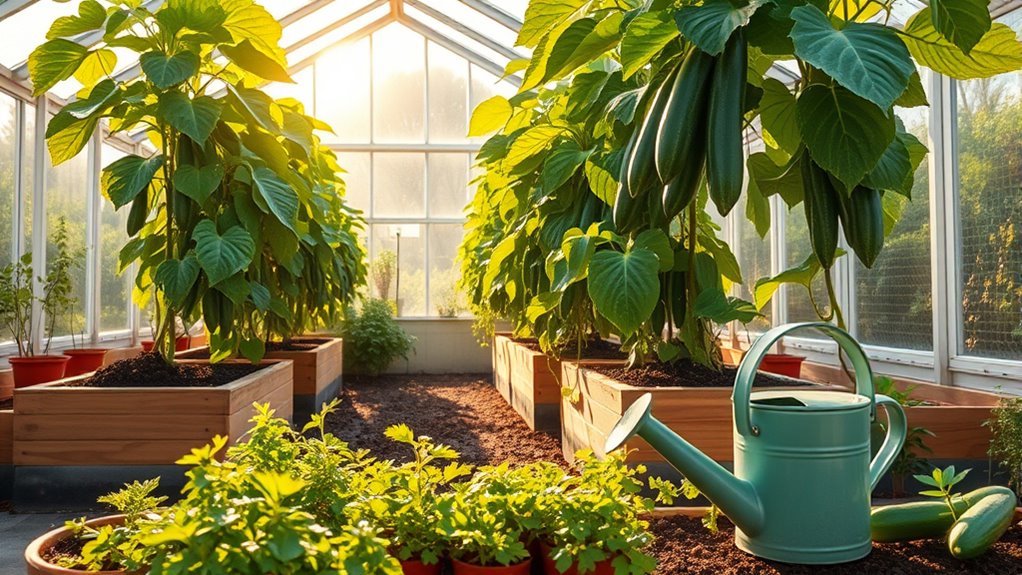
To successfully grow cucumbers in your greenhouse, you'll need to create an ideal environment that supports their growth. Aim for temperatures between 75° and 80°F during the day, and maintain humidity levels of 60% to 70%.
Proper lighting is essential; cucumbers thrive with high light intensity, so consider supplemental lighting if necessary. Use a well-drained soil or soilless medium with a pH between 5.5 and 6.8.
Make sure to ventilate your greenhouse effectively to prevent moisture buildup and reduce disease risks. Installing fans or vents will help maintain good air circulation.
Starting Cucumber Seeds

Starting cucumber seeds is an essential step in your greenhouse gardening journey. To get the best results, sow your seeds indoors 6-8 weeks before you plan to transplant.
Use a heated propagator for faster germination, as seeds sprout in 5-7 days at ideal temperatures of at least 68°F (20°C). Plant seeds 1-2 cm deep in seed compost, making sure you position them on their side to prevent rotting.
Keep seedlings above 59°F (15°C) and provide bright light for healthy growth. Water well after sowing and maintain consistent moisture.
Thin seedlings to one per pot after germination and pot them into larger containers after a month. Monitor for pests and diseases to guarantee strong growth.
Transplanting and Training Cucumbers
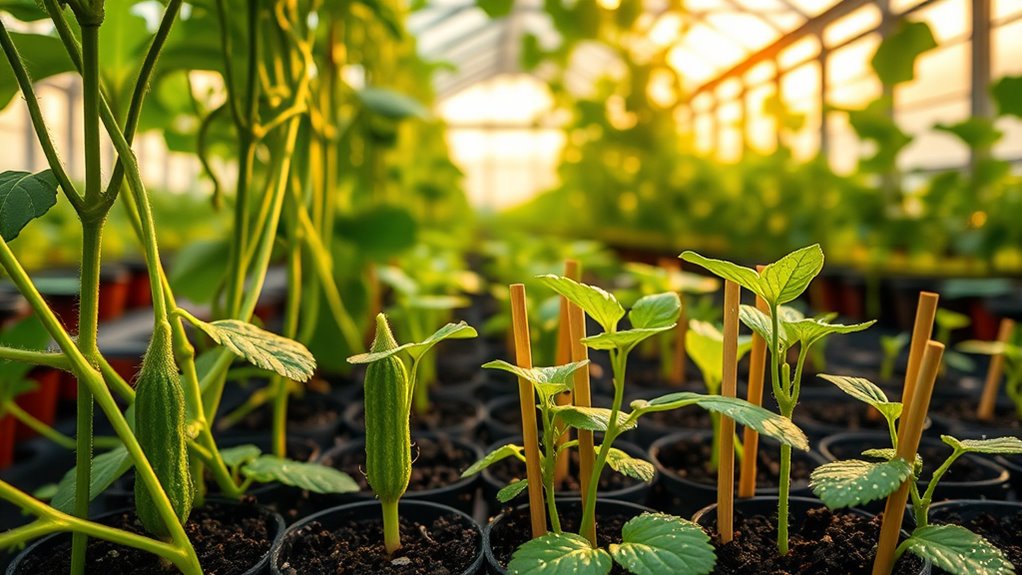
As your cucumber seedlings reach about two months old, it's time to transplant them into the greenhouse for ideal growth.
Make sure the soil temperature is at least 60°F (15.5°C), but preferably around 70°F (21°C). Use soil blocks or deep cell flats to minimize root damage during transplanting. Space your cucumbers about 12 to 15 inches apart for maximum air circulation.
Once transplanted, guide the main shoots up a trellis to maximize vertical space and encourage larger cucumbers.
Pinch out the growing point when it reaches the roof, and remove side shoot tips once they hit 60cm (2ft) to promote fruiting. Support your plants with bamboo canes or trellises for stability as they grow.
Managing Pests and Diseases

While growing cucumbers in a greenhouse offers a controlled environment, it also creates an ideal habitat for pests and diseases. To keep your plants healthy, regularly monitor them for common pests like aphids, whiteflies, and spider mites.
Implement Integrated Pest Management (IPM) strategies, such as using yellow sticky traps and beneficial insects like predatory mites and parasitic wasps. For diseases, focus on sanitation and crop rotation to minimize pathogen buildup.
Biofungicides, like *Trichoderma harzianum*, can effectively protect against soil-borne diseases. Additionally, choose disease-resistant cucumber varieties and maintain proper irrigation practices to prevent overwatering, which encourages fungal growth.
Harvesting Cucumbers

When you've nurtured your cucumber plants to maturity, knowing how and when to harvest is essential for ideal flavor and quality. Aim to harvest when cucumbers are young and tender, typically 50 to 70 days after planting, at a size of 6 to 8 inches.
Use a sharp knife or secateurs to cut the fruit from the vine, ensuring you don't damage the plant. Regular harvesting encourages continuous fruiting and prevents bitterness.
Look for uniformly green, firm cucumbers with a slightly rounded tip. Check them regularly, especially in the cooler parts of the day, to maintain freshness.
Post-Harvest Care
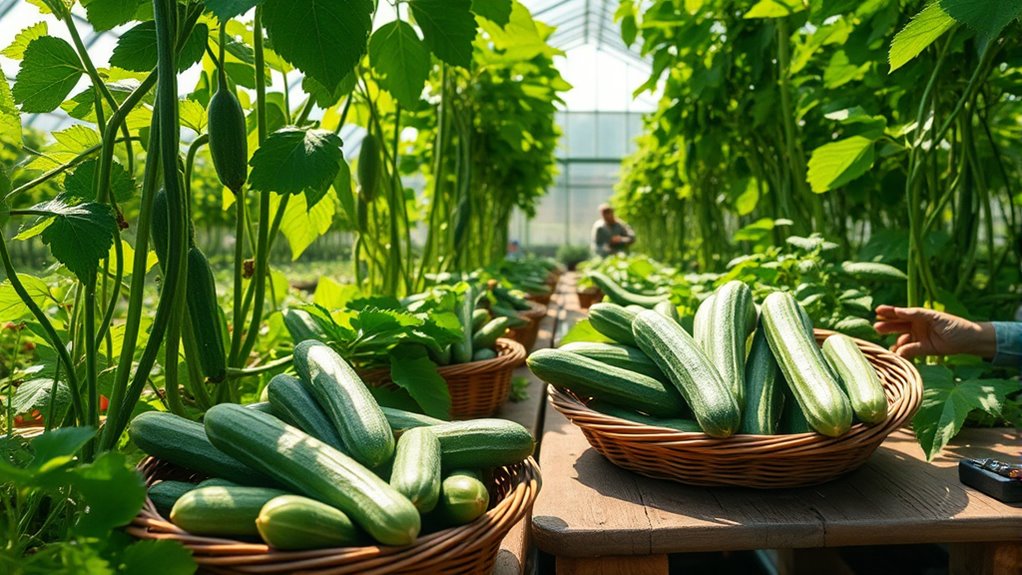
After you've harvested your cucumbers, proper post-harvest care is essential for maintaining their freshness and quality.
Quickly cool your cucumbers using hydrocooling or forced-air methods to remove field heat. Store them in chill rooms at around 50°F, which helps keep them crisp.
Quickly cool cucumbers with hydrocooling or forced-air methods, then store at 50°F to maintain their crispness.
Make certain to wash and sanitize your cucumbers to eliminate dirt and prevent microbial contamination. For packaging, consider wrapping or waxing them to enhance appearance and minimize moisture loss.
When transporting, use clean, sanitized containers to avoid cross-contamination. If you can't use them right away, refrigeration is best.
You can also preserve cucumbers through pickling or dehydrating for later enjoyment. Always follow hygiene practices throughout to guarantee safety and quality.
Tips for Maximizing Yield

To maximize your cucumber yield in a greenhouse, you'll want to focus on creating ideal environmental conditions and managing nutrients effectively.
Maintain temperatures between 70°F and 85°F, ensuring daytime warmth around 75°F to 77°F. Keep humidity levels balanced and provide at least six hours of direct sunlight daily. Consider enriching CO2 levels to boost yields considerably.
For nutrient management, aim for an electrical conductivity of 2.2 to 2.5, adjusting with fresh water or nutrient solutions as needed.
Watering frequency varies, so monitor plant size and climate. Use a mild liquid fertilizer every two months once fruits start growing.
For planting, space your cucumbers 16 inches apart and use trellising to maximize space and promote healthy growth.
Common Challenges and Solutions
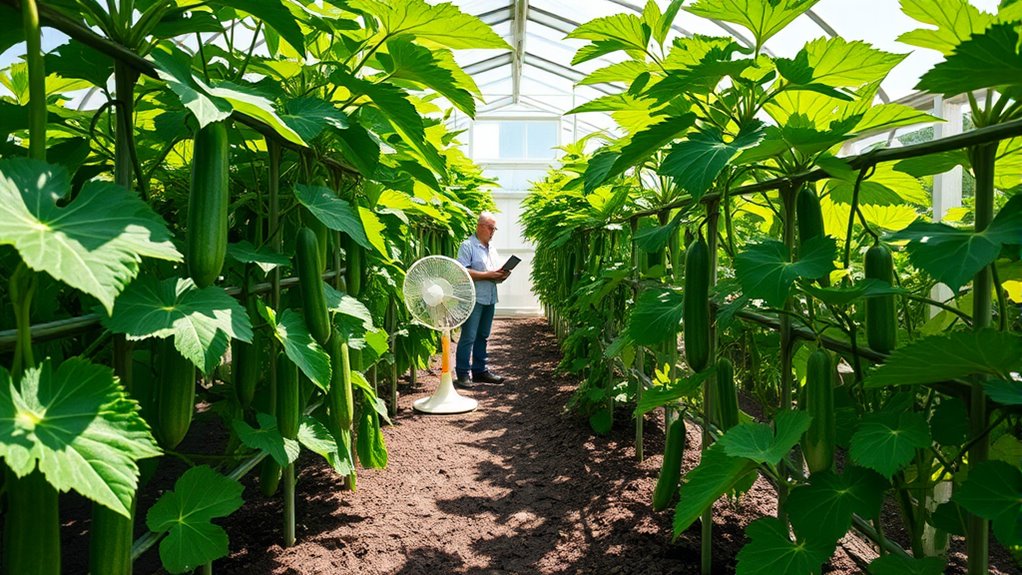
Growing cucumbers in a greenhouse can present several challenges, but understanding these issues allows you to implement effective solutions.
To tackle temperature extremes, maintain ventilation to keep the temperature below 90°F. Manage humidity carefully to prevent fungal diseases by guaranteeing good air circulation. For ideal light intensity, aim for at least 12 hours of light daily. Monitor soil temperature and keep it between 70°F and 85°F for germination success.
To control pests like red spider mites and cucumber beetles, incorporate biological methods and insect screening. Regularly check for diseases, maintain crop hygiene, and use beneficial insects for management.
Finally, guarantee a balanced nutrient supply through proper fertilization and consistent watering at the plant's base to prevent water stress.
Frequently Asked Questions
What Are the Best Cucumber Varieties for Beginners?
If you're starting your cucumber journey, consider beginner-friendly varieties like Mini Munch and Diva.
Mini Munch gives you small, tasty fruits, while Diva produces sweet, seedless cucumbers, making them super easy to grow.
You might also try F1 Bella for its disease resistance or Dishon for high yields.
These options will set you up for success, ensuring you enjoy fresh cucumbers without too much hassle.
Happy gardening!
How Often Should I Water My Cucumber Plants?
When it comes to watering cucumber plants, think of it as a dance—you need to find the right rhythm.
You'll want to provide about an inch of water per week under ideal conditions. However, in hot weather or drought, daily watering might be necessary.
Keep the soil consistently moist but not waterlogged, and consider using soaker hoses to avoid wet foliage, which can lead to diseases.
Balance is key for healthy growth!
Can I Grow Cucumbers Without a Greenhouse?
Yes, you can definitely grow cucumbers without a greenhouse!
Just make certain they get at least 6 hours of sunlight each day and keep the soil warm, ideally above 60°F. Use well-draining, fertile soil and maintain consistent moisture—without overwatering.
Plant seeds directly in the ground, spacing them 4-6 inches apart. Support vining varieties with trellises, and keep an eye out for pests and diseases to guarantee a healthy crop.
What Nutrients Do Cucumbers Need During Growth?
What nutrients do cucumbers need to thrive?
You'll want to focus on key elements like nitrogen for lush leaves, phosphorus for strong roots and flowers, and potassium for disease resistance.
Don't forget calcium and magnesium, which support cell strength and photosynthesis, respectively.
Maintaining a balanced nutrient mix and monitoring soil pH between 6.0 and 6.8 will help guarantee your cucumbers grow healthy and productive.
Regular feeding during their growth stages is essential!
How Do I Know When Cucumbers Are Overripe?
You can tell cucumbers are overripe when they start changing color to yellow or orange and grow larger than their ideal size.
Check for a soft or wrinkled skin, which indicates they're past their prime. If you notice a bitter taste, that's another sign.
Leaving them on the vine can also slow down production, so regular harvesting keeps your plants productive and healthy.
Conclusion
Growing cucumbers in a greenhouse can feel like cultivating a mini food factory, bursting with fresh produce! By choosing the right varieties and creating the perfect environment, you'll be well on your way to a bountiful harvest. Don't forget to manage pests and diseases, and with a little care, you'll be rewarded with crisp, juicy cucumbers. So, roll up your sleeves, enjoy the process, and soon you'll be swimming in cucumbers!
